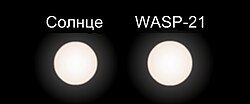 Size comparison between Sun and WASP-21 | |
| Observation data Epoch J2000 Equinox J2000 | |
|---|---|
| Constellation | Pegasus |
| Right ascension | 23 09 58.25 |
| Declination | +18° 23′ 45.9″ |
| Apparent magnitude (V) | 11.58 ± 0.08 |
| Characteristics | |
| Spectral type | G3V |
| Astrometry | |
| Radial velocity (Rv) | -89.45 km/s |
| Proper motion (μ) | RA: 17.597 ± 0.074 mas/yr Dec.: 18.867 ± 0.05 mas/yr |
| Parallax (π) | 3.8412 ± 0.0427 mas |
| Distance | 849 ± 9 ly (260 ± 3 pc) |
| Absolute magnitude (MV) | 4.97 |
| Details | |
| Mass | 0.89 ± 0.071 M☉ |
| Radius | 1.136 ± 0.049 R☉ |
| Surface gravity (log g) | 4.277 ± 0.025 cgs |
| Temperature | 5800 ± 100 K |
| Metallicity | -0.4 ± 0.1 |
| Metallicity | -0.46 ± 0.11 dex |
| Rotational velocity (v sin i) | 1.5 ± 0.6 km/s |
| Age | 12 ± 5 Gyr |
| Other designations | |
| Tangra, GSC 01715-00679, 2MASS J23095825+1823459, Gaia DR2 2831084391023184128 | |
| Database references | |
| SIMBAD | data |
WASP-21 is a G-type star (spectral type G3V) that is reaching the end of its main sequence lifetime approximately 850 light years from Earth in the constellation of Pegasus. The star is relatively metal-poor, having 40% of heavy elements compared to the Sun. Kinematically, WASP-21 belongs to the thick disk of the Milky Way. It has an exoplanet named WASP-21b.
The survey in 2012 have failed to find any stellar companions to WASP-21.
Naming
In 2019 the WASP-21 system was chosen as part of the NameExoWorlds campaign organised by the International Astronomical Union, which assigned each country a star and planet to be named. WASP-21 was assigned to Bulgaria. The winning proposal named the star Tangra after a deity worshipped by the early Bulgars, and the planet Bendida after a deity worshipped by the Thracians.
Planetary System
In 2010 WASP-21 was discovered to host a hot Jupiter type planet by the Wide Angle Search for Planets (WASP). and confirmed by radial velocity by the WASP team in 2010.
Transit-timing variation analysis in 2015 did not find an additional planets in the system.
In 2020, spectroscopic analysis has found the WASP-21 b atmosphere is mostly cloudless and contains sodium.
| Companion (in order from star) |
Mass | Semimajor axis (AU) |
Orbital period (days) |
Eccentricity | Inclination | Radius |
|---|---|---|---|---|---|---|
| b / Bendida | 0.276 ± 0.018 MJ | 0.0499 ± 0.0013 | 4.322482 | 0.0 | 86.97 ± 0.33° | 1.162 RJ |
References
- ^ Bouchy, F.; Hebb, L.; Skillen, I.; Collier Cameron, A.; Smalley, B.; Udry, S.; Anderson, D. R.; Boisse, I.; Enoch, B.; Haswell, C. A.; Hébrard, G.; Hellier, C.; Joshi, Y.; Kane, S. R.; Maxted, P. F. L.; Mayor, M.; Moutou, C.; Pepe, F.; Pollacco, D.; Queloz, D.; Ségransan, D.; Simpson, E. K.; Smith, A. M. S.; Stempels, H. C.; Street, R.; Triaud, A. H. M. J.; West, R. G.; Wheatley, P. J. (2010). "WASP-21b: A hot-Saturn exoplanet transiting a thick disc star". Astronomy and Astrophysics. 519: A98. arXiv:1006.2605. Bibcode:2010A&A...519A..98B. doi:10.1051/0004-6361/201014817. S2CID 119182669.
- ^ Brown, A. G. A.; et al. (Gaia collaboration) (August 2018). "Gaia Data Release 2: Summary of the contents and survey properties". Astronomy & Astrophysics. 616. A1. arXiv:1804.09365. Bibcode:2018A&A...616A...1G. doi:10.1051/0004-6361/201833051. Gaia DR2 record for this source at VizieR.
- ^ Ciceri, S.; Mancini, L.; Southworth, J.; Nikolov, N.; Bozza, V.; Bruni, I.; Calchi Novati, S.; d'Ago, G.; Henning, Th. (2013). "Simultaneous follow-up of planetary transits: Revised physical properties for the planetary systems HAT-P-16 and WASP-21". Astronomy & Astrophysics. 557: A30. arXiv:1307.5874. Bibcode:2013A&A...557A..30C. doi:10.1051/0004-6361/201321669. S2CID 55192357.
- Barros, S. C. C.; Pollacco, D. L.; Gibson, N. P.; Howarth, I. D.; Keenan, F. P.; Simpson, E. K.; Skillen, I.; Steele, I. A. (2011). "A lower mass for the exoplanet WASP-21b". Monthly Notices of the Royal Astronomical Society. 416 (4): 2593–2599. arXiv:1106.2118. Bibcode:2011MNRAS.416.2593B. doi:10.1111/j.1365-2966.2011.19210.x. S2CID 56165266.
- ^ Seeliger, M.; Kitze, M.; Errmann, R.; Richter, S.; Ohlert, J. M.; Chen, W. P.; Guo, J. K.; Göğüş, E.; Güver, T.; Aydın, B.; Mottola, S.; Hellmich, S.; Fernandez, M.; Aceituno, F. J.; Dimitrov, D.; Kjurkchieva, D.; Jensen, E.; Cohen, D.; Kundra, E.; Pribulla, T.; Vaňko, M.; Budaj, J.; Mallonn, M.; Wu, Z.-Y.; Zhou, X.; Raetz, St.; Adam, C.; Schmidt, T. O. B.; Ide, A.; et al. (2015), "Ground-based transit observations of the HAT-P-18, HAT-P-19, HAT-P-27/WASP40 and WASP-21 systems", Monthly Notices of the Royal Astronomical Society, 451 (4): 4060–4072, arXiv:1508.06215, Bibcode:2015MNRAS.451.4060S, doi:10.1093/mnras/stv1187, S2CID 56034663
- "Exoplanet-catalog". Exoplanet Exploration: Planets Beyond our Solar System. Retrieved 2022-12-10.
- Ginski, C.; Mugrauer, M.; Seeliger, M.; Eisenbeiss, T. (2012), "A lucky imaging multiplicity study of exoplanet host stars", Monthly Notices of the Royal Astronomical Society, 421 (3): 2498–2509, arXiv:1202.4586, Bibcode:2012MNRAS.421.2498G, doi:10.1111/j.1365-2966.2012.20485.x, S2CID 118573795
- "Bulgaria | NameExoworlds". Name Exoworlds. 2019-12-17. Retrieved 2019-12-30.
- Chen, G.; Casasayas-Barris, N.; Pallé, E.; Welbanks, L.; Madhusudhan, N.; Luque, R.; Murgas, F. (2020), "Detection of Na in WASP-21b's lower and upper atmosphere", Astronomy & Astrophysics, 642: A54, arXiv:2007.13429, Bibcode:2020A&A...642A..54C, doi:10.1051/0004-6361/202038661, S2CID 220793336
| Constellation of Pegasus | |||||||||||||
|---|---|---|---|---|---|---|---|---|---|---|---|---|---|
| Stars |
| ||||||||||||
| |||||||||||||
| Star clusters |
| ||||||||||||
| Nebulae |
| ||||||||||||
| Galaxies |
| ||||||||||||
| |||||||||||||
| |||||||||||||